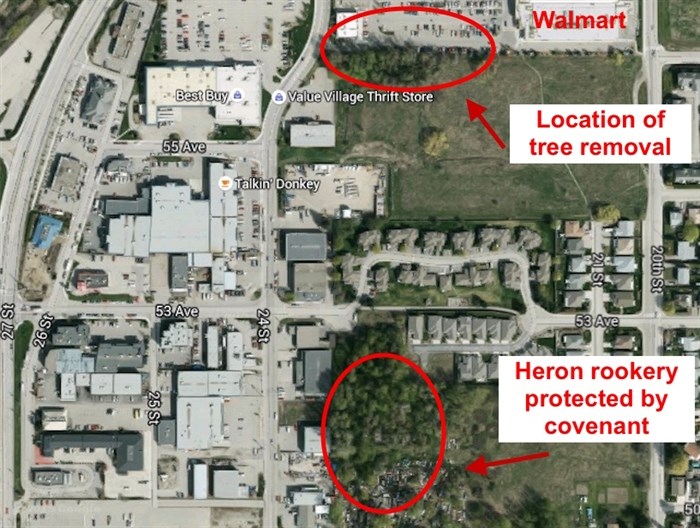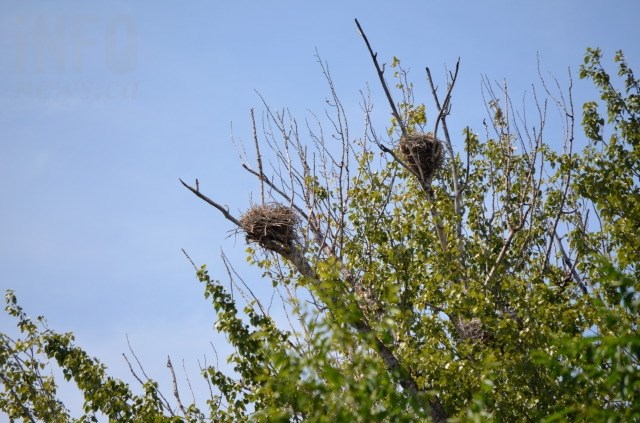
A stand of trees was chopped down Aug. 5 and 6 next to the Vernon Walmart parking lot in preparation for a new housing development.
(CHARLOTTE HELSTON / iNFOnews.ca)
August 13, 2015 - 4:30 PM
VERNON - A North Okanagan city is standing by its decision to allow a stand of trees to be chopped down despite concerns within the community it could impact an at-risk species of bird.
With a tree removal permit in hand from the City of Vernon, a housing developer removed the tall Cottonwood and poplar trees bordering the Walmart parking lot Aug. 5 and 6. The work has left some community members shocked and fearing adverse impacts on the Great Blue Herons that nest in the area.
The nine-acre property where the trees were removed is located roughly 200 metres from a well-known heron nesting area owned by longtime Vernon resident Jan Bos, who’s been observing the birds since the 1980s when they started nesting in the Cottonwood trees of his lot. There are now approximately 60-70 nests there and as many as 225 chicks hatched this year, Bos says.
He signed an agreement with local government in 1992 which placed a covenant on his 1.5 acre property, forbidding any tree removal or tampering with the habitat. And while the birds are safe on his protected property, he says they require additional habitat, some of which he insists was lost when the trees by Walmart were cut down last week.
“The herons don’t just live on my property,” Bos says. “They function much the same as if you have kids, the neighbourhood is part of it.”
He says the herons used the now chopped down trees for resting in after fishing expeditions in Swan Lake and gathering building materials for their nests. Chicks would also travel there from the rookery in early flying lessons, he says. Cottonwoods are among the tree varieties preferred by the birds.
“This is just another straw in the demise of the herons,” Bos says.
But the development company insists it wasn’t aware of any herons using the trees for habitat when it obtained a tree removal permit from the city.
“That’s one of the first things we checked on,” Len Sloan, with Mission Meadows Development Corp. says. “We were assured from the city there were no birds nesting there.”
City of Vernon planning manager Dale Rintoul says the subject trees 'have not been and were not heron host trees’ nor were any herons observed there.
“So when this developer came in, that was part of the review — whether those trees needed to be kept — and it was not determined they needed to be kept in that corner,” Rintoul says.
Sightings of herons in the removed trees have so far been solely anecdotal, and there are no photos to show if they were ever there.
Unlike Bos’ property, Rintoul says the lot in question was, historically, ‘not determined to be a heronry that needed special protection.’ Rintoul adds the trees were prone to breakage and falling limbs, posing a safety risk.
The Barnard’s Village housing project is for 78 rancher style homes to be rolled out over the next several years. Construction is slated to start this month.

Map illustrating the location of the removed trees and the nearby heron rookery.
Image Credit: Google Maps/ Composite by Charlotte Helston

Great Blue Heron nests at the rookery owned by Jan Bos, located about 200 metres from the Barnard's Village housing development site.
(CHARLOTTE HELSTON / iNFOnews.ca)

In this 2007 photo, you can see the trees that used to border the Walmart parking lot.
Image Credit: City of Vernon report

(CHARLOTTE HELSTON / iNFOnews.ca)
To contact the reporter for this story, email Charlotte Helston at chelston@infonews.ca or call 250-309-5230. To contact the editor, email mjones@infonews.ca or call 250-718-2724.
News from © iNFOnews, 2015